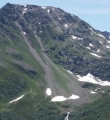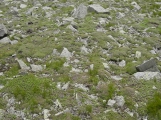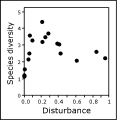 |
|
|
|
|
|
|
There are manifold effects of disturbance on alpine vegetation ranging in their effects from the death of individual plants or small patches of vegetation to more severe impacts over large areas. Infrequent but severe disturbances (such as large landslides and volcanic eruptions) may be catastrophic for the existing vegetation and, if so, will be followed by primary succession. On many regularly disturbed areas, plant communities have evolved that are adapted to these particular environmental conditions: |
 1 1
 2 2
 3 3
|
|
Vegetation development in areas exposed to very frequent disturbance such as freeze-thaw and solifluction may be permanently arrested in an early successional state. |
|
The intermediate-disturbance hypothesis predicts that the diversity of species in an ecosystem is highest at intermediate levels of disturbance. Because of the high frequency and diversity of disturbance, this hypothesis is of particular importance in alpine environments. If we compare the response of vegetation in the lowlands and the alpine environment to
similar disturbances, we may see differences. These may be related not only to differences in disturbance
intensity, but to other interacting factors such as constraints of resource availability on plant growth
and the pool of available species that can cope with such disturbances. |
29 August 2011 |
||
| |
||
